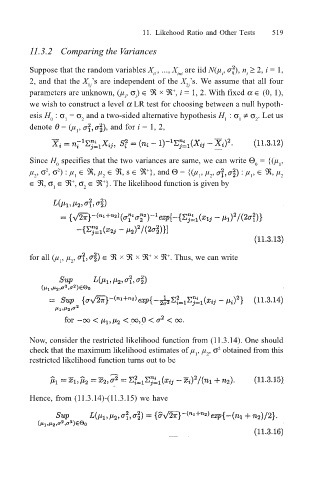Page 542 - Probability and Statistical Inference
P. 542
11. Likehood Ratio and Other Tests 519
11.3.2 Comparing the Variances
Suppose that the random variables X , ..., X are iid N(µ , ), n ≥ 2, i = 1,
i1 ini i i
2, and that the X s are independent of the X s. We assume that all four
1j 2j
+
parameters are unknown, (µ , σ ) ∈ ℜ × ℜ , i = 1, 2. With fixed α ∈ (0, 1),
i i
we wish to construct a level α LR test for choosing between a null hypoth-
esis H : σ = σ and a two-sided alternative hypothesis H : σ ≠ σ . Let us
0 1 2 1 1 2
denote θ = (µ , , and for i = 1, 2,
1
Since H specifies that the two variances are same, we can write Θ = {(µ ,
0 0 1
2
µ , σ , σ ) : µ ∈ ℜ, µ ∈ ℜ, s ∈ ℜ }, and Θ = {(µ , µ , : µ , ∈ ℜ, µ
+
2
2 1 2 1 2 1 2
∈ ℜ, σ ∈ ℜ , σ ∈ ℜ }. The likelihood function is given by
+
+
1 2
for all (µ , µ , ∈ ℜ × ℜ × ℜ × ℜ . Thus, we can write
+
+
1 2
Now, consider the restricted likelihood function from (11.3.14). One should
check that the maximum likelihood estimates of µ , µ , σ obtained from this
2
1
2
restricted likelihood function turns out to be
Hence, from (11.3.14)-(11.3.15) we have

